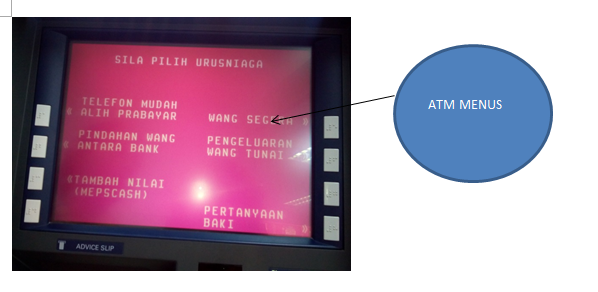Iconic Representation
The use of image or symbol to recall signs and improve the
recognition. There are 4 type of iconic representation:
Similar Icon
Use of image that similar to the action, concept and object
Example: Image of people exit from the place
Example Icon
Use of image as example to show the complex action, concept and object
Example:
Image of umbrella and motorcyclist
Symbolic Icon
Use of recognizable object to represent to the action, concept and object
Example:
Symbolic icon in escalator signs
Example:
Arbitrary icon in backpack
Affordance
This design of bag had 2 different of carry. This design of 2 carry bag make users know how to use the carry whether wants to grip or hang up at the back of body.
Similar Icon
Use of image that similar to the action, concept and object
Example: Image of people exit from the place
Figure 6.1
Picture above show the symbol of people exit the place. Similar iconic representation can be found in this picture as the action of people exit the place can easily be understand.
Example Icon
Use of image as example to show the complex action, concept and object
Example:
Image of umbrella and motorcyclist
Figure 6.1.1
The image above show the icon of umbrella and motorcycle. It use to represent the place as the shelter during rainy day
Use of recognizable object to represent to the action, concept and object
Example:
Symbolic icon in escalator signs
Figure 6.1.2
Use of image that has no relationship with the action, concept and object.
The figure above show the warning sign in the escalator. The symbol of trolley is to represent that user cannot bring the trolley on the escalator.
Arbitrary Icon
Example:
Arbitrary icon in backpack
Figure 6.1.3
The figure above show the tumble drying sign. The icon is use at the most clothing and fabric product as guide for the user about do's and don't when cleaning the product.
Characteristic of product that effect its function
Example: Magnet button in the bag
Figure 6.2
The image above the magnet button on the bag. The magnet button use to seal the bag so that the things from the bag cannot easily fall out.
Constraint
Constraints have limit possible action that can performed on a system. We use constraints in design to simply usability and minimize errors. There are 2 type of constraint:
Psychological Constraints
Used to improve the clarity and intuitiveness of design. Psychological constraints limit the range of possible actions by the way people perceive and think about the world which is symbols, conventions and mapping. Symbols influence behavior by communicating through language, such as text, icon and warning sign.
Example: Rice cooker box
Example: Rice cooker box
Figure 6.3
Physical Constraints
Used to reduce the sensitivity of controls, minimize unintentional input and prevent dangerous actions. Limit range of possible actions by redirecting physical motion in specific which is path, axes and barriers.
Example: Warning symbol of water heater
Example: Warning symbol of water heater
The designer use the icon and text to make better understanding to users.
Figure 6.3.1
The sticker warning is important to remind user for awareness. It is for users safety when use the water heater.
Visibility
Visibility is a system usable to indicate status, the possible actions that can be performed and the consequences of the actions once performed. The principle of visibility is based on the fact that people can be better at recognizing solutions when selecting from a set of options, then recalling solutions from memory. Visible controls and information serve as reminders for the possible outcome from our mind.
Figure 6.4
ATM machine is visibility system where determine the user ID and password before proceed cash withdrawal. The ATM machine provides selecting option for menus. Therefore, the users should memorize their on key password and knows to use ATM machine.
Mental Model
People are tendency to understand how the system works based on the mental representation of the experience.
People are tendency to understand how the system works based on the mental representation of the experience.
The figure above show the image of mineral bottle. The user can recall on how to open the bottle which is by twist the bottle cap based on their experience before on how it works.
Mapping
Good mapping means the design of an object effects the users to use it easily when their know how to control their action on that object.
Good mapping means the design of an object effects the users to use it easily when their know how to control their action on that object.
Example : grip carry and back support carry
Figure 6.6
This design of bag had 2 different of carry. This design of 2 carry bag make users know how to use the carry whether wants to grip or hang up at the back of body.














No comments:
Post a Comment